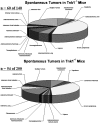Tnk1/Kos1: a novel tumor suppressor
- PMID: 20697568
- PMCID: PMC2917161
Tnk1/Kos1: a novel tumor suppressor
Abstract
Tnk1/Kos1 is a non-receptor protein tyrosine kinase implicated in negative regulation of cell growth by a mechanism involving inhibition of Ras activation and requiring Tnk1/Kos1's intrinsic catalytic activity. Tnk1/Kos1 null mice were created by homologous recombination by deleting the catalytic domain. Upon aging, both Tnk1+/- and Tnk1-/- mice develop spontaneous tumors, including lymphomas and carcinomas at high rates (i.e. 27%, and 43%, respectively), indicating that Tnk1/Kos1 is a tumor suppressor. Tissues from Tnk1/Kos1-null mice exhibit proportionally higher levels of basal and growth factor-stimulated Ras activation. Mechanistically, Tnk1/Kos1 requires either or both Y277 and Y287 sites to be intact for enzymatic activity and phosphorylation of its substrate, growth factor receptor binding protein 2 (Grb2). Data indicate that following tyrosine phosphorylation of Grb2 by Tnk1/Kos1, the Grb2-Sos1 guanine exchange factor (GEF) complex that mediates growth factor stimulated Ras activation becomes disrupted, resulting in the reversal of Ras activation. Conversely, the loss of Tnk1/Kos1 activity results in constitutive activation of Ras due to prolonged stabilization/activation of the Grb2-Sos1 GEF activity. Tnk1/Kos1 is the first tyrosine kinase discovered to have tumor suppressor activity, and the mechanism of spontaneous tumor formation involves constitutive, indirect activation of Ras. Thus, Ras may display "oncogenic activity" without undergoing "oncogenic" mutation. We now find that a cohort of patients with diffuse large B-cell lymphoma (DLBCL) display downregulation of Tnk1/Kos1 that may account for tumorigenesis in humans.
Figures






Similar articles
-
Tnk1/Kos1 knockout mice develop spontaneous tumors.Cancer Res. 2008 Nov 1;68(21):8723-32. doi: 10.1158/0008-5472.CAN-08-1467. Cancer Res. 2008. PMID: 18974114
-
Kos1, a nonreceptor tyrosine kinase that suppresses Ras signaling.Oncogene. 2003 Jun 5;22(23):3562-77. doi: 10.1038/sj.onc.1206480. Oncogene. 2003. PMID: 12789265
-
Functional characterization of the murine Tnk1 promoter.Gene. 2009 Sep 1;444(1-2):1-9. doi: 10.1016/j.gene.2009.05.010. Epub 2009 May 27. Gene. 2009. PMID: 19481140 Free PMC article.
-
High-throughput RNAi screening identifies a role for TNK1 in growth and survival of pancreatic cancer cells.Mol Cancer Res. 2011 Jun;9(6):724-32. doi: 10.1158/1541-7786.MCR-10-0436. Epub 2011 May 2. Mol Cancer Res. 2011. PMID: 21536687 Free PMC article.
-
Activation of Ras by receptor tyrosine kinases.J Am Soc Nephrol. 1994 Dec;5(6):1288-99. doi: 10.1681/ASN.V561288. J Am Soc Nephrol. 1994. PMID: 7893993 Review.
Cited by
-
ACK1 is dispensable for development, skin tumor formation, and breast cancer cell proliferation.FEBS Open Bio. 2021 Jun;11(6):1579-1592. doi: 10.1002/2211-5463.13149. Epub 2021 May 2. FEBS Open Bio. 2021. PMID: 33730447 Free PMC article.
-
miR-663b promotes colorectal cancer progression by activating Ras/Raf signaling through downregulation of TNK1.Hum Cell. 2020 Jan;33(1):104-115. doi: 10.1007/s13577-019-00294-w. Epub 2019 Nov 23. Hum Cell. 2020. PMID: 31758392
-
Drosophila activated Cdc42 kinase has an anti-apoptotic function.PLoS Genet. 2012;8(5):e1002725. doi: 10.1371/journal.pgen.1002725. Epub 2012 May 17. PLoS Genet. 2012. PMID: 22615583 Free PMC article.
-
A Novel Putative Role of TNK1 in Atherosclerotic Inflammation Implicating the Tyk2/STAT1 Pathway.Mediators Inflamm. 2020 Jul 10;2020:6268514. doi: 10.1155/2020/6268514. eCollection 2020. Mediators Inflamm. 2020. PMID: 32694928 Free PMC article.
-
Deep learning prioritizes cancer mutations that alter protein nucleocytoplasmic shuttling to drive tumorigenesis.Nat Commun. 2025 Mar 14;16(1):2511. doi: 10.1038/s41467-025-57858-8. Nat Commun. 2025. PMID: 40087285 Free PMC article.
References
-
- Neet K, Hunter T. Vertebrate non-receptor protein-tyrosine kinase families. Genes Cells. 1996;1:147–69. - PubMed
-
- Schlessinger J. Cell signaling by receptor tyrosine kinases. Cell. 2000;103:211–25. - PubMed
-
- Fischer EH, Charbonneau H, Tonks NK. Protein tyrosine phosphatases: a diverse family of intracellular and transmembrane enzymes. Science. 1991;253:401–6. - PubMed
-
- Avraham H, Avraham S, Taniguchi Y. Receptor protein tyrosine phosphatases in hematopoietic cells. J Hematother Stem Cell Res. 2000;9:425–32. - PubMed
-
- Erpel T, Courtneidge SA. Src family protein tyrosine kinases and cellular signal transduction pathways. Curr Opin Cell Biol. 1995;7:176–82. - PubMed
Publication types
MeSH terms
Substances
Grants and funding
LinkOut - more resources
Full Text Sources
Other Literature Sources
Research Materials
Miscellaneous
